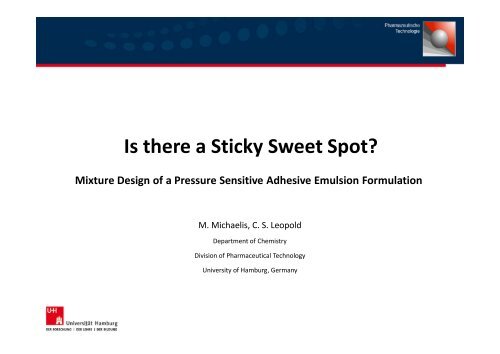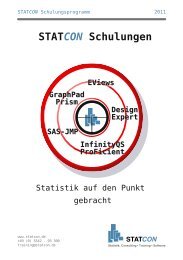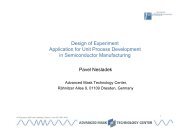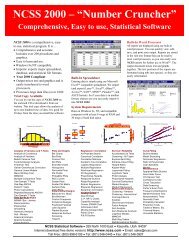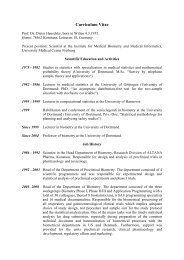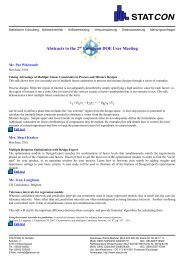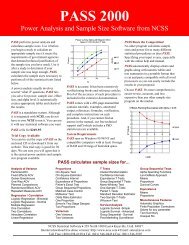Download - Statcon
Download - Statcon
Download - Statcon
You also want an ePaper? Increase the reach of your titles
YUMPU automatically turns print PDFs into web optimized ePapers that Google loves.
Is there a Sticky Sweet Spot?<br />
Mixture Design of a Pressure Sensitive Adhesive Emulsion Formulation<br />
1<br />
M. Michaelis, C. S. Leopold<br />
Department of Chemistry<br />
Division of Pharmaceutical Technology<br />
University of Hamburg, Germany
Aim of the study<br />
Formulation of an adhesive mixture for transdermal patches that<br />
comprises:<br />
1. Improved adhesion properties<br />
2. Improved solubility of an Active Pharmaceutical Ingredient (API)<br />
2
Introduction<br />
Transdermal Therapeutic Systems (TTS)<br />
Patches for transdermal application of<br />
APIs to achieve a systemic effect<br />
About 50 TTS products on the market<br />
14 Active Pharmaceutical Ingredients<br />
Mostly Drug In Adhesive Design (DIA)<br />
+ Controlled drug delivery<br />
+ Good compliance<br />
API level in blood<br />
http://www.nipro-patch.co.jp<br />
- Stability issues<br />
- Lack of adhesion<br />
3<br />
http://www.pharmainfo.net<br />
Crystalization of API<br />
http://www.acino-pharma.com<br />
Drug In Adhesive Design<br />
http://www.novartis.com.ph<br />
Backing<br />
Drug in Adhesive<br />
Release liner<br />
http://www.quit.org.au<br />
Lack of adhesion
Introduction<br />
Pressure Sensitive Adhesives (PSAs)<br />
Pressure Sensitive Adhesives:<br />
Tacky at room temperature<br />
Adhere to a variety of surfaces on light pressure<br />
Adhere permanently<br />
Ûsed in a lot of common products<br />
Adhesive Performance<br />
Tack: Ability to form a bond of measurable strength by<br />
simple contact with a surface (stickiness)<br />
Shear Adhesion: Ability to resist structural failure<br />
(cohesiveness)<br />
Peel Resistance: Force required to remove the tape without<br />
leaving residues<br />
4
Materials<br />
Component 1: Polyacrylate<br />
DuroTak® 387-2287<br />
2-Ethylhexyl acrylate<br />
Vinyl acetate<br />
Hydroxyethyl acrylate<br />
Component 2: Silicone Adhesive<br />
BIO-PSA® 7-4302<br />
Component 3: Oleyl Alcohol<br />
Surfactant<br />
Component 4: Ibuprofen<br />
API / model drug<br />
(high dose analgetic)<br />
5<br />
Oleyl Alcohol<br />
67 %<br />
28 %<br />
5 %<br />
Ibuprofen
Design<br />
Mixture Design<br />
3 (4) Components<br />
Components<br />
Design space with constraints IV Optimal Design<br />
Suggested design: 16 runs, 5 replicates, 5 to estimate lack of fit<br />
Evaluation: FDS Graph<br />
Low<br />
[%]<br />
High<br />
[%]<br />
Polyacrylate Adhesive 20 70<br />
Silicone Adhesive 10 60<br />
Oleyl Alcohol 0 10<br />
Ibuprofen 20<br />
Total 100<br />
6<br />
= Design Space<br />
= Replicate x 2<br />
= Replicate x 3
Preparation of adhesive matrix/specimen<br />
1. Components were dissolved in ethyl acetate (wet mix) and mixed in a shaker at<br />
90 rpm for 15 min.<br />
2. Wet mix was coated on a release liner<br />
3. Films were dried at 80 °C for 30 min in an oven Adhesive matrix (a) - 100 µm thick<br />
4. Films were laminated with a backing membrane Specimen (b)<br />
a) Coating Knife<br />
Release Liner<br />
Drug In Adhesive<br />
7<br />
b)<br />
Backing Membrane<br />
Release Liner<br />
Drug In Adhesive
Response 1 & 2:<br />
1. Tack<br />
Probe Tack Test at 21 °C<br />
Adhesive matrix (a)<br />
Stainless steel probe 3 mm<br />
Contact time 1 s, contact force 0.4 N<br />
Response: Stress maximum max [N/mm²]<br />
2. Shear Adhesion<br />
Test specimen (b) was attached to<br />
a stainless steel plate<br />
Area: 12 x 12 mm, weight: 250 g<br />
Response: Time to failure t [min]<br />
8<br />
Probe Tack Test<br />
Shear adhesion
Response 3 & 4:<br />
3. Crystal growth<br />
Area of 100 cm 2 of the adhesive matrix<br />
after 24 h<br />
Response: Area covered by crystals in %<br />
of the whole area<br />
4. Creaming behavior (phase separation)<br />
Bottle with wet mix after 24 h<br />
Separated phase of wet mix in % of the<br />
wet mix<br />
9<br />
1:1 1:100<br />
no creaming<br />
20 % creaming
Response 5 & 6<br />
5. Droplet size<br />
Matrix was transferred to a glass slide<br />
Microscope with 100-fold magnification<br />
Response: Mean of droplet diameter of 30 droplets [µm]<br />
6. Droplet distribution range<br />
Response: Maximum range of 30 droplets [µm]<br />
small & narrow large & narrow small & broad large & broad<br />
10
Analysis<br />
Model<br />
Normal Plot<br />
Transformation<br />
Fit Summary and<br />
Model<br />
Lack of<br />
Fit<br />
Residuals<br />
vs.<br />
Predicted<br />
ANOVA<br />
Diagnostics<br />
11<br />
adj.<br />
R-square<br />
Externally<br />
Studentized<br />
Residuals<br />
Model Graphs<br />
pred.<br />
R-square<br />
Box-Cox<br />
Plot
Response Analysis 1: Tack<br />
Fit Summary and Model<br />
ANOVA<br />
Highest order polynomial: Reduced Special Quartic Model<br />
Model: 0.0001 significant<br />
Lack of fit: 0.3626 not significant<br />
Adj. R-square: 0.9226<br />
Pred. R-square: 0.8641<br />
Diagnostics<br />
Normal Plot<br />
Residuals vs. Predicted<br />
Externally Studentized Residuals<br />
Box-Cox plot<br />
Model Graphs<br />
12
Normal % Probability<br />
Normal % Probability<br />
Response 1: Tack - Diagnostics<br />
99<br />
95<br />
90<br />
80<br />
70<br />
50<br />
30<br />
20<br />
10<br />
5<br />
1<br />
Normal<br />
Normal<br />
Plot<br />
Plot<br />
of<br />
of Residuals<br />
Residuals<br />
-2.00 -1.00 0.00 1.00 2.00<br />
-2.00 -1.00 0.00 1.00 2.00<br />
Internally Studentized Residuals<br />
Internally Studentized Residuals<br />
13<br />
Internally Studentized Residuals<br />
3.00<br />
2.00<br />
1.00<br />
0.00<br />
-1.00<br />
-2.00<br />
-3.00<br />
Residuals<br />
Residuals<br />
vs.<br />
vs. Predicted<br />
Predicted<br />
-2.00 1.00 -1.00 1.50 0.00 2.00 1.00 2.50 2.00 3.00<br />
Predicted<br />
Predicted
Externally Studentized Residuals<br />
Externally Studentized Residuals<br />
Response 1: Tack - Diagnostics<br />
6.00<br />
4.00<br />
2.00<br />
0.00<br />
-2.00<br />
-4.00<br />
-6.00<br />
Externally Externally Studentized Residuals Residuals<br />
1 4 7 10 13 16<br />
1 4 7 10 13 16<br />
Run Number<br />
Run Number<br />
14<br />
Ln(ResidualSS)<br />
Ln (ResidualSS)<br />
-1.00<br />
-1.20<br />
-1.40<br />
-1.60<br />
-1.80<br />
Box-Cox-Plot Box-Cox Plot for for Power Power Transforms Transforms<br />
-3 -2 -1 0 1 2 3<br />
Lambda<br />
Lambda
2<br />
Response 1: Tack - Model Graphs<br />
100 % Polyacrylate = 0.50 N/mm²<br />
100 % Silicone = 0.55 N/mm²<br />
0.4<br />
2<br />
60.000<br />
B: Silicone<br />
A: Acrylat<br />
70.000<br />
0.000 10.000<br />
0.3<br />
3<br />
0.2<br />
2<br />
0.2<br />
20.000<br />
Tack<br />
Design points below predicted value<br />
50.000<br />
C: Oleyl Alcohol<br />
15<br />
Tack<br />
0.5<br />
0.4<br />
0.3<br />
0.2<br />
0.1<br />
C (0.000)<br />
A (70.000)<br />
B (10.000)<br />
B (60.000) A (20.000)<br />
C (50.000)
Normal % Probability<br />
Normal % Probability<br />
99<br />
95<br />
90<br />
80<br />
70<br />
50<br />
30<br />
20<br />
10<br />
5<br />
1<br />
Response 2: Shear Adhesion - Diagnostics<br />
Fit Summary and Model<br />
ANOVA<br />
Highest order polynomial: Quadratic Model<br />
Model: 0.0001 significant<br />
Lack of fit: 0.6446 not significant<br />
Adj. R-square: 0.99875<br />
Pred. R-square: 0.9734<br />
Diagnostics<br />
Normal Plot of Residuals<br />
-2.00 -1.00 0.00 1.00 2.00<br />
Internally Studentized Residuals<br />
Internally Studentized Residuals<br />
Internally Studentized Residuals<br />
Internally Studentized Residuals<br />
3.00<br />
2.00<br />
1.00<br />
0.00<br />
-1.00<br />
-2.00<br />
-3.00<br />
Residuals vs. Predicted<br />
0.00 0.20 0.40 0.60 0.80 1.00 1.20 1.40 1.60<br />
Predicted<br />
16<br />
Externally Studentized Residuals<br />
Externally Studentized Residuals<br />
4.00<br />
2.00<br />
0.00<br />
-2.00<br />
-4.00<br />
Externally Studentized Residuals<br />
1 4 7 10 13 16<br />
Run Number<br />
Ln(ResidualSS)<br />
Ln (ResidualSS)<br />
10.00<br />
8.00<br />
6.00<br />
4.00<br />
2.00<br />
0.00<br />
Recommended<br />
transformation:<br />
Log<br />
Normal Plot of Residuals Residuals vs. Predicted Externally Studentized Residuals Box-Cox Plot for Power Transforms<br />
Box-Cox Plot for Power Transforms<br />
-3 -2 -1 0 1 2 3<br />
Predicted Run Number Lambda<br />
Lambda
2<br />
Response 2: Shear Adhesion - Model Graphs<br />
100 % Polyacrylate = 17.2min<br />
100 % Silicone = 56.9 min<br />
20<br />
2<br />
15<br />
60.000<br />
B: Silicone<br />
5<br />
3<br />
A: Acrylat<br />
70.000<br />
2<br />
Design-Expert® Software<br />
Component Coding: Actual<br />
Original Scale<br />
(median estimates)<br />
Shear<br />
Design points above predicted value<br />
Design points below predicted value<br />
30.2<br />
1.4<br />
0.000 10<br />
10.000<br />
20.000<br />
Shear Shear Adhesion<br />
X1 = A: Acrylat<br />
X2 = B: Silicone<br />
X3 = C: Oleyl Alcohol<br />
50.000<br />
C: Oleyl Alcohol<br />
17<br />
Shear Shear Adhesion<br />
30.2<br />
23<br />
15.8<br />
8.6<br />
1.4<br />
C (0.000)<br />
A (70.000)<br />
B (10.000)<br />
B (60.000) A (20.000)<br />
C (50.000)
Normal % Probability<br />
Normal % Probability<br />
99<br />
95<br />
90<br />
80<br />
70<br />
50<br />
30<br />
20<br />
10<br />
5<br />
1<br />
Response 3: Crystal Growth - Diagnostics<br />
Fit Summary and Model<br />
ANOVA<br />
Highest order polynomial: Reduced Cubic Model<br />
Model: 0.0001 significant<br />
Lack of fit: 0.7984 not significant<br />
Adj. R-square: 0.9819<br />
Pred. R-square: 0.9702<br />
Diagnostics<br />
Normal Plot of Residuals Residuals vs. Predicted Externally Studentized Residuals Box-Cox Plot for Power Transforms<br />
Normal Plot of Residuals<br />
-3.00 -2.00 -1.00 0.00 1.00 2.00<br />
Internally studentized residuals<br />
Internally Studentized Residuals<br />
Internally Studentized Residuals<br />
Internally Studentized Residuals<br />
3.00<br />
2.00<br />
1.00<br />
0.00<br />
-1.00<br />
-2.00<br />
-3.00<br />
Residuals vs. Predicted<br />
2 2<br />
0.00 20.00 40.00 60.00 80.00 100.00<br />
Predicted<br />
18<br />
Externally Studentized Residuals<br />
Externally Studentized Residuals<br />
6.00<br />
4.00<br />
2.00<br />
0.00<br />
-2.00<br />
-4.00<br />
-6.00<br />
Externally Studentized Residuals<br />
1 4 7 10 13 16<br />
Run Number<br />
Ln(ResidualSS)<br />
Ln (ResidualSS)<br />
30.00<br />
25.00<br />
20.00<br />
15.00<br />
10.00<br />
5.00<br />
0.00<br />
Box-Cox Plot for Power Transforms<br />
-3 -2 -1 0 1 2 3<br />
Predicted Run Number Lambda<br />
Lambda
Response 3: Crystal Growth - Model Graphs<br />
Crystal Growth<br />
100 % Polyacrylate= 70 %<br />
100 % Silicone= 100 %<br />
2<br />
2<br />
60.000<br />
B: Silicone<br />
A: Acrylat<br />
70.000<br />
0.000 20<br />
10.000<br />
100<br />
60<br />
80<br />
40<br />
3<br />
0<br />
2<br />
0<br />
0<br />
20.000<br />
20<br />
Crystal Growth<br />
Design points below predicted value<br />
50.000<br />
C: Oleyl Alcohol<br />
19<br />
Crystal Growth<br />
120<br />
100<br />
80<br />
60<br />
40<br />
20<br />
0<br />
-20<br />
C (0.000)<br />
A (70.000)<br />
B (10.000)<br />
B (60.000) A (20.000)<br />
C (50.000)
Normal % Probability<br />
Normal % Probability<br />
99<br />
95<br />
90<br />
80<br />
70<br />
50<br />
30<br />
20<br />
10<br />
5<br />
1<br />
Response 4: Creaming behavior - Diagnostics<br />
Fit Summary and Model<br />
ANOVA<br />
Highest order polynomial: Reduced Cubic Model<br />
Model: 0.0001 significant<br />
Lack of fit: 0.6410 not significant<br />
Adj. R-square: 0.9460<br />
Pred. R-square: 0.7104<br />
Diagnostics<br />
Normal Plot of Residuals Residuals vs. Predicted Externally Studentized Residuals Box-Cox Plot for Power Transforms<br />
Normal Plot of Residuals<br />
-2.00 -1.00 0.00 1.00 2.00<br />
Internally Studentized Residuals<br />
Internally Studentized Residuals<br />
Internally Studentized Residuals<br />
Internally Studentized Residuals<br />
3.00<br />
2.00<br />
1.00<br />
0.00<br />
-1.00<br />
-2.00<br />
-3.00<br />
Residuals vs. Predicted<br />
5.00 10.00 15.00 20.00 25.00 30.00<br />
Predicted<br />
20<br />
Externally Studentized Residuals<br />
Externally Studentized Residuals<br />
6.00<br />
4.00<br />
2.00<br />
0.00<br />
-2.00<br />
-4.00<br />
-6.00<br />
Externally Studentized Residuals<br />
1 4 7 10 13 16<br />
Run Number<br />
Ln(ResidualSS)<br />
Ln (ResidualSS)<br />
9.00<br />
8.00<br />
7.00<br />
6.00<br />
5.00<br />
4.00<br />
3.00<br />
Box-Cox Plot for Power Transforms<br />
-3 -2 -1 0 1 2 3<br />
Predicted Run Number Lambda<br />
Lambda
2<br />
Response 4: Creaming Behavior -<br />
Model Graphs<br />
10<br />
2<br />
15<br />
60.000<br />
B: Silicone<br />
A: Acrylat<br />
70.000<br />
0.000 10.000<br />
20<br />
25<br />
3<br />
25<br />
20<br />
15<br />
2<br />
10<br />
20.000<br />
Creaming Creaming<br />
Design-Expert® Software<br />
Component Coding: Actual<br />
Creaming<br />
Design points above predicted value<br />
Design points below predicted value<br />
27.3743<br />
4.44444<br />
X1 = A: Acrylat<br />
X2 = B: Silicone<br />
X3 = C: Oleyl Alcohol<br />
50.000<br />
C: Oleyl Alcohol<br />
21<br />
Creaming<br />
30<br />
25<br />
20<br />
15<br />
B (60.000)<br />
10<br />
5<br />
0<br />
C (0.000)<br />
A (20.000)<br />
A (70.000)<br />
B (10.000)<br />
C (50.000)
Normal Normal % % Probability<br />
Response 5: Droplet Size - Diagnostics<br />
99<br />
95<br />
90<br />
80<br />
70<br />
50<br />
30<br />
20<br />
10<br />
5<br />
1<br />
Fit Summary and Model<br />
ANOVA<br />
Highest order polynomial: Reduced Cubic Model<br />
Model: 0.0001 significant<br />
Lack of fit: 0.1123 not significant<br />
Adj. R-square: 0.9733<br />
Pred. R-square: 0.7747<br />
Diagnostics<br />
Normal Plot of Residuals Residuals vs. Predicted Externally Studentized Residuals Box-Cox Plot for Power Transforms<br />
Normal Plot of Residuals<br />
-3.00 -2.00 -1.00 0.00 1.00 2.00 3.00<br />
Internally Studentized Residuals<br />
Internally Studentized Residuals<br />
Internally Studentized Residuals<br />
Internally Studentized Residuals<br />
3.00<br />
2.00<br />
1.00<br />
0.00<br />
-1.00<br />
-2.00<br />
-3.00<br />
2<br />
Residuals vs. Predicted<br />
0.00 10.00 20.00 30.00 40.00<br />
Predicted<br />
2<br />
22<br />
Externally Studentized Residuals<br />
Externally Studentized Residuals<br />
6.00<br />
4.00<br />
2.00<br />
0.00<br />
-2.00<br />
-4.00<br />
-6.00<br />
Externally Studentized Residuals<br />
1 4 7 10 13 16<br />
Run Number<br />
Ln(ResidualSS)<br />
Ln (ResidualSS)<br />
8.00<br />
7.00<br />
6.00<br />
5.00<br />
4.00<br />
3.00<br />
2.00<br />
Box-Cox Plot for Power Transforms<br />
-3 -2 -1 0 1 2 3<br />
Predicted Run Number Lambda<br />
Lambda
2<br />
Response 5: Droplet Size - Model Graphs<br />
10<br />
2<br />
40<br />
60.000<br />
B: Silicone<br />
A: Acrylat<br />
70.000<br />
0.000 10.000<br />
30<br />
20<br />
3<br />
10<br />
2<br />
20.000<br />
Droplet Size<br />
Design-Expert® Software<br />
Component Coding: Actual<br />
Droplet Size<br />
Design points above predicted value<br />
Design points below predicted value<br />
40<br />
3.75<br />
X1 = A: Acrylat<br />
X2 = B: Silicone<br />
X3 = C: Oleyl Alcohol<br />
50.000<br />
C: Oleyl Alcohol<br />
23<br />
Droplet Size<br />
Droplet Size<br />
50<br />
B (60.000)<br />
40<br />
30<br />
20<br />
10<br />
0<br />
C (0.000)<br />
A (20.000)<br />
A (70.000)<br />
B (10.000)<br />
C (50.000)
Normal % Probability<br />
Normal % Probability<br />
99<br />
95<br />
90<br />
80<br />
70<br />
50<br />
30<br />
20<br />
10<br />
5<br />
1<br />
Response 6: Droplet Distribution Range -<br />
Diagnostics<br />
Fit Summary and Model<br />
ANOVA<br />
Highest order polynomial: Reduced Cubic Model<br />
Model: 0.0001 significant<br />
Lack of fit: 0.2831 not significant<br />
Adj. R-square: 0.9230<br />
Pred. R-square: 0.7410<br />
Diagnostics<br />
Normal Plot of Residuals<br />
-2.00 -1.00 0.00 1.00 2.00<br />
Internally Studentized Residuals<br />
Internally Studentized Residuals<br />
Internally Studentized Residuals<br />
Internally Studentized Residuals<br />
3.00<br />
2.00<br />
1.00<br />
0.00<br />
-1.00<br />
-2.00<br />
-3.00<br />
Residuals vs. Predicted<br />
0.00 2.00 4.00 6.00 8.00 10.00<br />
Predicted<br />
2<br />
24<br />
Externally Studentized Residuals<br />
Externally Studentized Residuals<br />
6.00<br />
4.00<br />
2.00<br />
0.00<br />
-2.00<br />
-4.00<br />
-6.00<br />
Externally Studentized Residuals<br />
1 4 7 10 13 16<br />
Run Number<br />
Ln(ResidualSS)<br />
Ln (ResidualSS)<br />
12.00<br />
10.00<br />
8.00<br />
6.00<br />
4.00<br />
Recommended<br />
Transformation:<br />
Square Root<br />
Normal Plot of Residuals Residuals vs. Predicted Externally Studentized Residuals Box-Cox Plot for Power Transforms<br />
Box-Cox Plot for Power Transforms<br />
-3 -2 -1 0 1 2 3<br />
Predicted Run Number Lambda<br />
Lambda
2<br />
Response 6: Droplet Distribution Range -<br />
Model Graphs<br />
2<br />
60.000<br />
B: Silicone<br />
A: Acrylat<br />
70.000<br />
0.000 10.000<br />
60<br />
40<br />
20<br />
3<br />
2<br />
20.000<br />
Droplet Droplet Distribution Distribution Range<br />
Design points above predicted value<br />
Design points below predicted value<br />
50.000<br />
C: Oleyl Alcohol<br />
25<br />
Droplet Distribution<br />
Droplet Distribution Range<br />
80<br />
60<br />
B (60.000)<br />
40<br />
20<br />
0<br />
C (0.000)<br />
A (20.000)<br />
A (70.000)<br />
B (10.000)<br />
C (50.000)
2<br />
2<br />
60.000<br />
B: Silicone<br />
Discussion: Response 3 & 5 & 6<br />
A: Acrylat<br />
70.000<br />
0.000 20<br />
10.000<br />
100<br />
40<br />
60<br />
80<br />
3<br />
0<br />
2<br />
0<br />
0<br />
20.000<br />
20<br />
Crystal Growth<br />
50.000<br />
C: Oleyl Alcohol<br />
2<br />
10<br />
2<br />
40<br />
60.000<br />
B: Silicone<br />
A: Acrylat<br />
70.000<br />
10<br />
0.000 10.000<br />
30<br />
20<br />
3<br />
2<br />
20.000<br />
Droplet Size<br />
26<br />
50.000<br />
C: Oleyl Alcohol<br />
2<br />
2<br />
60.000<br />
B: Silicone<br />
A: Acrylat<br />
70.000<br />
0.000 10.000<br />
60<br />
40<br />
20<br />
3<br />
2<br />
20.000<br />
Droplet Distribution<br />
50.000<br />
C: Oleyl Alcohol<br />
Crystal Growth Droplet Size Droplet Distribution Range
Optimization<br />
Constrains<br />
Solutions<br />
Lower Upper Lower Upper<br />
Name Goal Limit Limit Weight Weight Importance<br />
A:Acrylate is in range 20 70 1 1 3<br />
B:Silicone is in range 10 60 1 1 3<br />
C:Oleyl Alcohol is in range 0 10 1 1 3<br />
Tack maximize 0.3 0.41 1 1 3<br />
Shear Adhesion maximize 5.0 30.2 1 1 3<br />
Crystal Growth is target = 0 0 10.0 1 1 5<br />
Droplet Size minimize 3.75 40 1 1 3<br />
Droplet Distribution minimize 2.5 70 1 1 3<br />
Number Acrylate Silicone Oleyl Alcohol Tack<br />
27<br />
Shear<br />
Adhesion<br />
Crystal<br />
Growth<br />
Droplet<br />
Size<br />
Droplet<br />
Distribution Desirability<br />
1 20.2 59.8 0.0 0.41 26.19 4.81 7.3 5.0 0.750<br />
2 45.0 35.0 0.0 0.31 12.89 0.53 10.9 4.4 0.540
Optimization<br />
2<br />
2<br />
0.600<br />
60.000<br />
B: Silicone<br />
A: Acrylat<br />
70.000<br />
0.000 10.000<br />
0.400<br />
0.600<br />
0.200<br />
Prediction 0.750<br />
0.400<br />
3<br />
2<br />
Prediction 0.540<br />
20.000<br />
Desirability<br />
28<br />
50.000<br />
C: Oleyl Alcohol
Conclusion<br />
Is there a sticky sweet spot?<br />
No, there is not.<br />
But…<br />
29
Conclusion<br />
We know that:<br />
Oleyl alcohol neither stabilizes the polymer-polymer interaction nor the<br />
polymer-API interaction.<br />
Oleyl alcohol decreases the adhesion properties in most cases.<br />
Wet mixes with equal amounts of polymer tend to be less stable.<br />
The best results were found at the periphery of the design space.<br />
Crystal growth correlates with droplet size and droplet distribution.<br />
No profit of oleyl alcohol, the addition is unnecessary.<br />
Limited processing time must be taken into account for scale up.<br />
Design space needs to be augmented.<br />
Do process variables such as mixing speed or viscosity of the wet mix have<br />
an influence on crystal growth? (combined – design)<br />
30
Thank you!<br />
31


